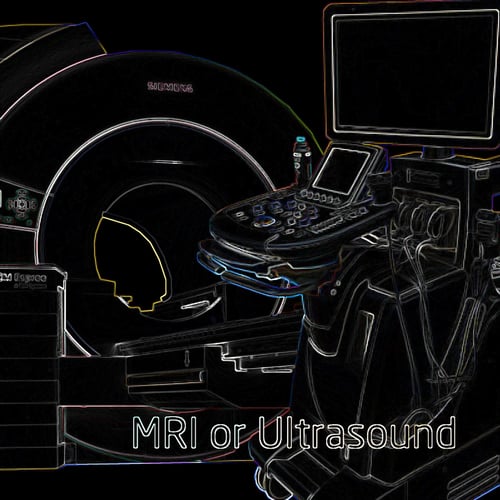There are so many ways to take a peek inside the body, from X-rays and CT scans to MRIs and high resolution ultrasound. When dealing with aches, pains and other issues with the musculoskeletal system, how does a doctor decide which medical imaging equipment is right?
dealing with aches, pains and other issues with the musculoskeletal system, how does a doctor decide which medical imaging equipment is right?
Today, we’ll look at the differences between an MRI and an ultrasound.
An MRI uses powerful magnets to produce 3-D anatomic images. It provides high contrast resolution to determine changes in the tissue quality. For example, with a muscle injury, MRI images will often show a bright signal. This indicates that there is more water in the muscle, which means it’s been injured.
An ultrasound uses high-frequency sound waves that provides images of organs and structure with a high-spatial resolution modality. This provides great internal details. If you looked at the same muscle injury with an ultrasound, you’d see individual fibers of the muscle and early changes of the injury.
While both ultrasound and MRI can detect large muscle tears in tissues, ultrasound can provide better views of microtears and chronic injuries. Ultrasound can also pinpoint the location of a patient’s pain and correlate it to an issue with a particular structure. Unlike an MRI, ultrasound can also let the clinician observe what happens during movement. Structures that an MRI can’t evaluate can be well evaluated with ultrasound, including the fascia, nerves and chronically injured muscles.
Ultrasound also goes beyond being just a diagnostic tool. It’s ideal when an injection treatment is needed, like a corticosteroid shot into a joint. The ultrasound allows the clinician to visualize the structure to make sure the needle is placed in the correct location. While image-guided joint injections can be performed with X-rays or CT scans, with ultrasound, there is no need for a contrast dye to be injected.
But ultrasound isn’t the end-all, be-all. It can’t show the structures inside joints. Instead, it can only show the soft tissues outside the joint. MRI is a better choice to evaluate bone, cartilage or other structures inside and around a joint. In addition, ultrasound can only probe a small area at a time, whereas MRI is ideal for conditions that impact deep or large areas.
In The Market For Ultrasound, MRI or Other Medical Imaging Equipment?
Before you take the leap, be sure to consider a refurbished or used medical imaging system. Oftentimes, used radiology equipment can deliver the performance you need, as well as a solid warranty—at a much more affordable price. Talk to one of the experts at Atlantis Worldwide today and see if a used or refurbished MRI, ultrasound, CT or X-ray is right for you.
Some blogs you may have missed:
- MRI Infographic: Closed Bore, Open MRI & Wide Bore
- Confused About MRI Coils?
- 7 Benefits of Medical Imaging File Sharing
- 3D Printing in Medical Imaging & Healthcare
- Free Medical Imaging Resources
Meet the author: Vikki Harmonay




